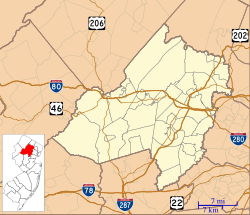
The Morristown Line is an NJ Transit commuter rail line connecting Morris and Essex counties to New York City, via either New York Penn Station or Hoboken Terminal. Out of 60 inbound and 58 outbound daily weekday trains, 28 inbound and 26 outbound Midtown Direct trains use the Kearny Connection to Penn Station; the rest go to Hoboken. Passengers can transfer at Newark Broad Street or Summit to reach the other destination. On rail system maps the line is colored dark green, and its symbol is a drum, a reference to Morristown's history during the American Revolution.

Morristown is a NJ Transit rail station on the Morristown Line, located in Morristown, in Morris County, New Jersey, United States. It serves an average of 1,800 passengers on a typical weekday. Construction of the historic station began in 1912 and the facility opened November 3, 1913. A station agent and waiting room are available weekdays. The station's interior was featured in Cyndi Lauper's "Time After Time" video in 1984. Just west of the station, at Baker Interlocking, the Morristown and Erie Railway branches off the NJT line. The M&E's offices and shop are here.
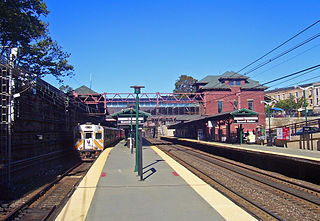
Summit is a train station in Summit, New Jersey, served by New Jersey Transit's Morris & Essex Lines. The station sits between Union Place on the north and Broad Street on the south, with station access via either side, and between Summit Avenue on the east and Maple Avenue on the west. Constructed in 1904–1905 by the Delaware, Lackawanna and Western Railroad in a mile-long open cut, it is one of the few NJ Transit stations with platforms below street level.

Brick Church is an active commuter railroad station in the city of East Orange, Essex County, New Jersey. The station, one of two in East Orange, is located next to the Temple of Unified Christians Brick Church, designed with brick architecture. The other station, located 0.6 miles (0.97 km) to the east, is the namesake East Orange stop. Trains from the station head east on New Jersey Transit's Morristown Line and Gladstone Branch to New York Penn Station and Hoboken Terminal while westbound trains service stops out to Gladstone and Hackettstown. Like its sister station, Brick Church contains three tracks and two platforms. However, it is not accessible for the handicapped.

Highland Avenue is an active commuter railroad station in the city of Orange, Essex County, New Jersey. One of two in the city, along with the eponymous Orange station, Highland Avenue is serviced by trains of New Jersey Transit's Morris and Essex Lines: the Morristown Line and Gladstone Branch. Trains through the station run between New York Penn Station and Hoboken Terminal to the east and Hackettstown and Gladstone. The station contains two low-level side platforms for the three tracks that run through the station.

Mountain Station is a New Jersey Transit station in South Orange, Essex County, New Jersey, United States, along the Morris and Essex. The station, built in 1915, was designed by Frank J. Nies. It has been listed in the New Jersey Register of Historic Places and National Register of Historic Places since 1984 and is part of the Operating Passenger Railroad Stations Thematic Resource.
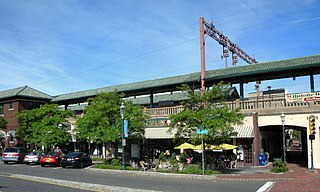
South Orange is a New Jersey Transit station in South Orange, New Jersey along the Morris and Essex rail line. It is located in the business district of South Orange, near its town hall. It is one of two train stations in the township of South Orange, Mountain Station being the other near the township border. South Orange station was built by the Lackawanna Railroad in 1916.

Maplewood is a train station that serves New Jersey Transit's Morristown Line and Gladstone Branch in the township of Maplewood, Essex County, New Jersey. Located in downtown Maplewood at 145 Dunnell Road, the station services trains from New York Penn Station and Hoboken Terminal to the east along with trains to Summit, Dover, Hackettstown and Gladstone to the west.
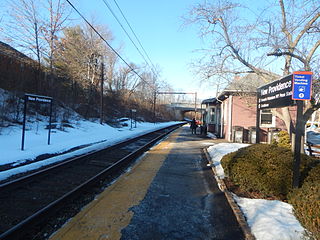
New Providence is a New Jersey Transit station in New Providence, New Jersey along the Gladstone Branch of the Morris and Essex line. The original 1899 station, built by the Delaware, Lackawanna and Western Railroad still stands. New Providence station is located across from the intersection of Old Springfield Avenue and Division Avenue. Springfield Avenue was rerouted north of the station in 1931. The former segment of Springfield Avenue on the opposite side of the tracks has been turned into an additional parking lot.

Denville is an active commuter railroad train station in Denville Township, Morris County, New Jersey. Located on Estling Road, the station contains three side platforms–two curved low-level platforms that service New Jersey Transit's Morristown Line, and a third that services their Montclair-Boonton Line. Both platforms on the Morristown Line contain miniature high-level platforms for handicap accessibility. Trains on both lines operate between Hoboken Terminal, New York Penn Station and Hackettstown. Heading westbound, the next station is Dover while the next station east on the Morristown Line is Mount Tabor. The next station east on the Montclair-Boonton Line is Mountain Lakes.

Dover is an active commuter railroad train station in the borough of Dover, Morris County, New Jersey. Located at the end of electric service, Dover station serves as a secondary terminal of NJ Transit's Morristown and Montclair-Boonton Lines. Non-electric service continues west to Hackettstown on both lines. The next station to the west is Mount Arlington while the next station to the east is Denville. Dover station consists of a single island platform, accessible for the handicapped.

Mount Arlington is a commuter railroad station for New Jersey Transit. Located in the borough of Mount Arlington, Morris County, New Jersey, United States, the station is located next to interchange 30 on Interstate 80. The station serves as a park-and-ride for commuters to catch trains for Hoboken Terminal and New York Penn Station. Trains use the Montclair-Boonton Line and Morristown Line to serve locales between Hackettstown and the eastern terminals. Lakeland Bus Lines also services Mount Arlington station. The station is handicapped accessible as part of the Americans with Disabilities Act of 1990. The station features two side platforms and two tracks with elevators.

Lake Hopatcong is a commuter railroad station for New Jersey Transit. The station, located in the community of Landing in Roxbury Township, Morris County, New Jersey, United States, serves trains for the Montclair-Boonton Line and Morristown Line at peak hours and on holiday weekends. Service from Lake Hopatcong provides to/from Hackettstown to New York Penn Station and Hoboken Terminal. The stop is located on the tracks below Landing Road next to the eponymous Lake Hopatcong. The station consists of one active and one abandoned side platform, along with a shelter on the active platform. There is no accessibility for handicapped persons under the Americans with Disabilities Act of 1990.

Mount Olive is a NJ Transit station in Mount Olive, New Jersey, located in the International Trade Center. The station, located on the side of Waterloo Village Road, services trains for both the Montclair-Boonton Line and the Morristown Line along trackage owned by Norfolk Southern. The line is not electrified from Hackettstown to Dover, where passengers can transfer to an electric Morristown Line train via Summit or a diesel Montclair-Boonton train via Wayne and Montclair. Trains along both lines head to Hoboken Terminal in Hoboken, New Jersey or New York Penn Station at 34th Street in New York City, although Montclair-Boonton trains require a transfer at Montclair State University or Newark Broad Street for electrified service to New York. It is also the least-used station in the NJ Transit commuter rail network.

Lyons is a New Jersey Transit station in Basking Ridge, New Jersey along the Gladstone Branch of the Morris & Essex Lines. The station serves south Basking Ridge as well as the Hills and Liberty Corner.

Bloomfield is a New Jersey Transit station in Bloomfield, New Jersey along the Montclair-Boonton Line. The station is located in downtown Bloomfield, the second within the municipality, just west of Bloomfield Avenue. This is the second station within the township served on the line after Watsessing Avenue station.
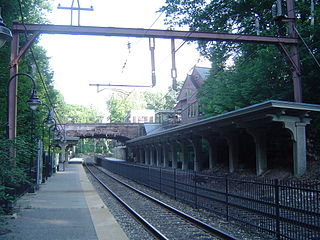
Glen Ridge is a New Jersey Transit station at the intersection of Bloomfield Avenue and Ridgewood Avenue in Glen Ridge, Essex County, New Jersey along the Montclair-Boonton Line. Service through Glen Ridge comes from Hoboken Terminal and New York Penn Station and goes through to one of four termini, Bay Street, Montclair State University, Dover and Hackettstown. The station depot is on-grade level with Ridgewood Avenue, with the platform and tracks below street-level.

Lincoln Park is a station on NJ Transit's Montclair-Boonton Line in the borough of Lincoln Park, Morris County, New Jersey. The station is located near the Comly Road overpass, accessible from Main Street, Station Road and Park Avenue.
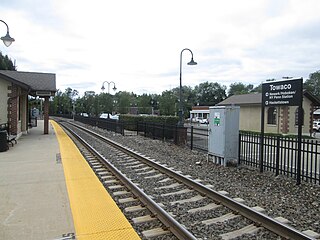
Towaco is a station on NJ Transit's Montclair-Boonton Line located between U.S. Route 202 and Whitehall Road in the eponymous neighborood of Montville Township, Morris County, New Jersey. The station opened as Whitehall in 1870 along the Boonton Branch of the Delaware, Lackawanna and Western Railroad, and assumed its current name in 1905.

Roseville Avenue was a transfer station on New Jersey Transit's Morris & Essex Lines in Newark, New Jersey, United States. The station was built by the Delaware, Lackawanna and Western Railroad in 1903 as part of a project to lower the tracks below the road surface to eliminate grade crossings. It serviced Newark's Roseville neighborhood. It once had two tracks on the Lackawanna mainline and two low-wall platforms, with an additional platform along the Montclair Branch. The station remained in service during most of the 20th century, until New Jersey Transit closed the station on September 16, 1984.


